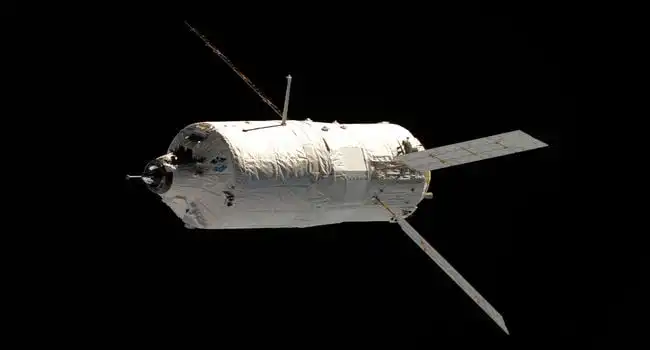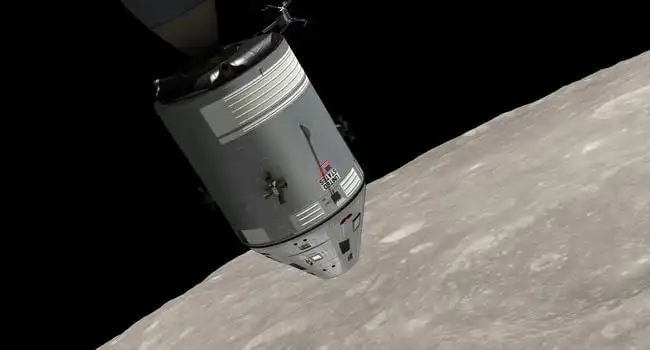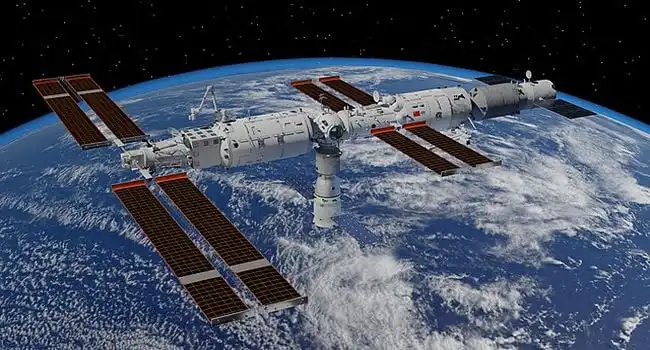As technology advances, so too does humanity’s ability to explore and better understand our universe. From the iPhone to the Hubble Space Telescope, each technological development has made it possible to further our understanding of the world around us. One of the most remarkable examples of this advancement is the use of satellites in space. From the International Space Station to the moon, satellites have been used to study the stars and planets, provide communication and navigation services, and even track the weather. Here are the 10 biggest and heaviest human made spacecraft of all time.
10- Salyut

The Soviet Union launched Salyut, the world’s first space station, in 1971. It was the largest man-made spacecraft ever made. It was a cylinder-shaped module with two solar panels extending outwards. Thus spacecraft had a pressurized habitable interior, giving cosmonauts a place to live and work in space. Salyut was equipped with a total of seven docking ports, allowing for the continual rotation of crews and resupply spacecraft. Its exterior also featured several scientific instruments, including two cameras, an ultraviolet telescope, and a gamma ray spectrometer. The station had a total of three successful crews, with the longest mission lasting nearly 180 days. It was eventually replaced by the Mir space station in 1986. Salyut had a major impact on space exploration and helped the Soviet Union establish its place as a leader in space exploration.
9- ATV

Photo Credit: Wikipedia
The European Space Agency launched the Automated Transfer Vehicle (ATV) in 2008. It was the largest spacecraft ever built by man. It measured 10.3 meters in length and 4.5 meters in diameter. Its cargo capacity was 6.6 metric tons, making it the heaviest spacecraft ever launched. ATV was designed to transport supplies to the International Space Station (ISS) and other spacecraft. Its cargo bay could hold over 5,000 items, including food, air, water and scientific equipment. It also had a propellant tank with enough fuel to maneuver the ISS in its orbit.
ATV was equipped with an advanced navigation system and rendezvous systems, allowing it to dock with the ISS easily and safely. Its thrusters and main engines could be used for attitude control, orbit corrections and station-keeping maneuvers. ATV was designed to operate autonomously to reduce the workload of the astronauts and mission control. After completing its mission, it was deorbited, burning up in the atmosphere over a remote area in the South Pacific. ATV was a remarkable feat of engineering, demonstrating the potential of human space exploration.
8- Orion

Photo Credit: Wikimedia
NASA and its partners are developing the Orion Multi-Purpose Crew Vehicle, the most advanced spacecraft ever built. It is designed to carry astronauts to destinations never before visited by humans, including an asteroid and Mars. Orion will launch atop NASA’s Space Launch System, the world’s most powerful rocket. The spacecraft will be larger and more capable than the Apollo capsules that took astronauts to the moon. Its crew module will be able to accommodate four astronauts for 21-day missions, and six astronauts for shorter missions. Its service module will provide propulsion, power, and life support for astronauts during their journey.
Orion will be outfitted with a heat shield to protect it from the intense heat of re-entry, as well as advanced parachutes to slow its descent. The spacecraft will be able to land in the ocean, and be recovered by ships. Orion will also be equipped with an emergency launch abort system to protect astronauts in the event of a launch emergency. The most advanced spacecraft ever built, Orion will help bring humans to destinations never before visited.
7- Apollo CSM

Photo Credit: NASA
The Apollo Command and Service Module (CSM) was the first of its kind. It was designed to take astronauts to the Moon and back. It had a cylindrical shape and was 30 feet long. The CSM was composed of two sections, the command module and the service module. The command module was the living quarters of the astronauts and contained the controls and the communications systems. The service module contained the propulsion system, fuel cells, and other systems to support the mission. It was the first spacecraft to have an onboard computer to control the operations.
The CSM also featured an oxygen and air circulation system, a thermal control system, and an electrical system. The spacecraft was equipped with an onboard guidance and navigation system and several telemetry systems to monitor the progress of the mission. The CSM was launched atop the Saturn V rocket and was capable of reaching speeds of up to 25,000 mph. The CSM was a marvel of engineering and a testament to human ingenuity. It was the most advanced spacecraft of its time and a major milestone for the space race.
6- Skylab

Photo Credit: Universe Today
Skylab was a first-of-its-kind US space station launched by NASA in 1973. It was the largest spacecraft ever built by humans at that time. Skylab orbited Earth for almost 6 years and was visited by three crews of astronauts. The first crew to visit Skylab was launched on May 14th, 1973. They fixed a jammed solar panel and replaced a faulty gyroscope. This mission lasted 28 days and set a record for the longest duration of a space mission. The second mission to visit Skylab was launched on July 28th, 1973.
This mission focused on medical and scientific experiments. The longest mission to Skylab lasted 84 days and was launched on November 16th, 1973. This mission focused on solar observations. Skylab’s last mission was launched on February 8th, 1974. This mission focused on repairing and upgrading Skylab. After 11 years of service, Skylab re-entered Earth’s atmosphere on July 11th, 1979, breaking apart and scattering debris over the Indian Ocean and parts of Western Australia.
5- Tiangong

Photo Credit: Wikimedia
China has launched its biggest man made spacecraft, Tiangong. It is a prototype space station for long term residence of astronauts. Its primary mission is to prepare for China’s planned space station in 2020. It was launched on September 29th, 2011. Tiangong is 30.5 m long and 10.4 m in diameter. It has two docking ports, one for cargo and one for crew. Its internal volume is 15 cubic meters and its space is the same as the size of a large bus.
It has two solar panels that can generate up to 5 KW of power. The spacecraft has a life span of two years and is equipped with advanced technologies and experiments. It has an advanced attitude control system and a propulsion system that use advanced attitude control and propulsion technologies. It also has a communication system that can be used to send data back to Earth. Tiangong is a key step for China’s space exploration program and is the first step towards establishing their own space station.
4- Buran

Photo Credit: 1945
The Buran, the biggest man made spacecraft ever, was developed by the Soviet Union in the 1980s. It was the first ever reusable spacecraft. It was designed to carry a crew of up to five people into low Earth orbit. The Buran was designed to be an orbital vehicle, able to remain in orbit for extended periods of time. It was capable of docking with other spacecraft, including the International Space Station. Its launch vehicle was the powerful Energia rocket, which was the most powerful launch vehicle ever built.
Its mission was to deliver payloads to space, including satellites, probes and crewed missions. The Buran made one successful unmanned test flight in 1988, but no additional flights were made. The program was eventually cancelled due to financial constraints. The Buran was the only fully developed reusable spacecraft to ever make an unmanned flight. It was a remarkable achievement for its time.
3- Space Shuttle Orbiter

The Space Shuttle Orbiter is the biggest man-made spacecraft. It was developed for NASA’s Space Shuttle program to provide efficient access to space. It is made up of a reusable orbiter vehicle, a pair of solid rocket boosters, and an expendable external fuel tank. The orbiter vehicle is the main component of the Space Shuttle system and is designed to carry astronauts, cargo, and experiments into space. It has three main components: the crew compartment, the mid-deck, and the payload bay.
The crew compartment is where the astronauts sit and control the spacecraft. The mid-deck is part of the orbiter that houses the astronauts’ living quarters, the onboard laboratory, and other equipment. The payload bay is the largest part of the orbiter, and is where the experiments and cargo are stored. The solid rocket boosters provide the main thrust needed to propel the orbiter vehicle into space. The external fuel tank is used to store the liquid hydrogen and liquid oxygen that the orbiter needs for its engines.
2- Mir

Photo Credit: Star Walk
The Soviet Union launched the Mir spacecraft in 1986. Mir was designed to last five years in space. Its mission was to conduct research and explore new technologies. It orbited the Earth for fifteen years, making it the longest-lived spacecraft. Mir contained six modules, each with its own purpose. The core module served as a living space for the cosmonauts and contained laboratories for experiments. Other modules contained solar panels to generate electricity, antennae for communication, and propulsion systems for maneuvering. The spacecraft was also equipped with robotic arms to assist in repair work. Mir was resupplied regularly by Progress supply vehicles and manned by Soyuz spacecrafts. In 2001, Mir’s orbit started to decay, and it was deorbited in a controlled burn. The Mir spacecraft left an incredible legacy in space exploration and technology.
1- ISS

The International Space Station is the largest man-made spacecraft ever constructed. It orbits Earth at an average altitude of 408 kilometers. The ISS modules were launched into space between 1998 and 2011. Its construction was completed in 2011. Its total mass is about 419,455 kilograms. It is 109 meters long, with a wingspan of 73 meters. It consists of 15 pressurized modules, two solar arrays, and various external components. Its pressurized modules provide living space for astronauts and scientists.
It is powered by eight solar arrays which generate 84 to 120 kilowatts of power. The ISS has a robotic arm that is used to move objects and astronauts outside the station. It also has two airlocks, which are used to move cargo and personnel in and out of the station. The ISS has an internal laboratory for conducting experiments in zero-gravity conditions. It has a library of over 1,400 books to help astronauts pass the time. It is an incredible engineering feat and a remarkable symbol of international cooperation.


